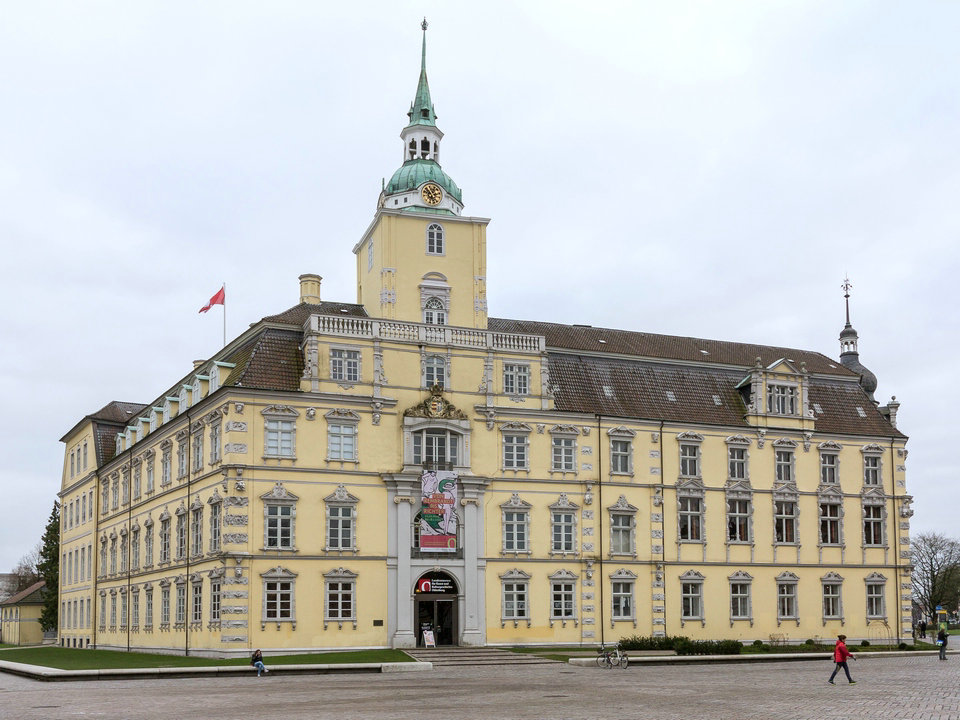Oldenburg State Museum for Art and Cultural History, Germany


The State Museum for Art and Cultural History (German: Landesmuseum für Kunst und Kulturgeschichte) is an art museum consisting of three separate buildings located close to each other in the city of Oldenburg, Lower Saxony, Germany.
The historical ensemble consisting of the Castle, Augusteum and Prinzenpalais houses the collections of the Oldenburg State Museum for Art and Cultural History. The former Grand Ducal collection of paintings formed the basis for today’s museum, which was founded in 1921 and opened in the Castle two years later. With a total collection of well over 30,000 paintings, paper art, cultural-history and applied-art objects, the State Museum is one of Northern Germany’s most varied museums. Regular major special exhibitions attract national attention and praise.
The museum was established in 1919 after the abdication the previous year of Frederick Augustus II, the last Grand Duke of Oldenburg. The initial collection consisted of the former Grand Duke’s picture gallery, a collection of antiquities, and the collections of the Museum of Decorative Arts and the former National Picture Gallery.
The three buildings are all located close to the northeast corner of the Schlossgarten Oldenburg, now Oldenburg’s main public park.
Schloss Oldenburg:
Schloss Oldenburg (Oldenburg palace) is a schloss, or palace, in the city of Oldenburg in the present-day state of Lower Saxony, Germany. It is the former residence of the counts (1667–1785), dukes (1785–1815) and grand dukes (1815–1918) of Oldenburg.
The building now houses part of the State Museum for Art and Cultural History, especially its decorative arts and local history exhibitions, as well as some old master paintings. Immediately outside the palace to the west and north is the Schlossplatz. Opposite it, to the north, is the Schlosshöfe shopping mall, opened in 2011. To the south are the Prinzenpalais and Augusteum, also part of the State Museum for Art and Cultural History. To the southwest is the Elisabeth-Anna-Palais, adjacent to the Schlossgarten Oldenburg, the main public park in Oldenburg.
In 1607–1667, the present palace served as the residence of Anthony Günther, Count of Oldenburg (1583–1667). After his death without a legitimate heir, most of his land fell into the hands of the Danish royal family for more than a hundred years. During this period, a Danish governor resided in the castle.
In 1773, the Holstein-Gottorf family took over control of the newly created Duchy of Oldenburg until 1860. In that year, Grand Duke Nikolas Peter Friedrich (1827–1900) moved to the nearby Prinzenpalais.
By 1894, the palace was the residence of the hereditary Grand Duke Friedrich August (1852–1931). He abdicated as reigning Grand Duke during the November Revolution of 1918, and in 1919–20 the palace was transformed into the Landesmuseum Oldenburg by the Government of the State of Oldenburg. It was transferred to public ownership in 1923.
Augusteum:
The Augusteum is an art museum in the city of Oldenburg, Lower Saxony, Germany. The museum houses the old master painting collection of the State Museum for Art and Cultural History.
The museum opened in 1876 as Oldenburg’s first art museum. The building is in the neo-Renaissance style. The Augusteum presents old master artworks including examples by Christian Griepenkerl and Johann Heinrich Wilhelm Tischbein. The Augusteum building is near the northeast corner of the Schlossgarten Oldenburg. The Prinzenpalais, Elisabeth-Anna-Palais, and Schloss Oldenburg are all close to the museum.
Prinzenpalais:
The Prinzenpalais is a palace, now used as an art museum, in the city of Oldenburg, Lower Saxony, Germany. The museum houses the modern art collection of the State Museum for Art and Cultural History.
The building dates from 1826 and is in the classical style. It was the residence of the Russian princes Alexander and Peter. Subsequently Grand Duke Niklaus Friedrich Peter occupied the building. In 2003, it became part of the State Museum of Art and Cultural History (with the Augusteum and Schloss Oldenburg) and is an art gallery. The museum concentrates on German artists, ranging from neoclassicism and Romanticism in the mid-19th century to the post-1945 era. The Prinzenpalais building is near the northeast corner of the Schlossgarten Oldenburg. The Augusteum, Elisabeth-Anna-Palais, and Schloss Oldenburg are all close to the museum.